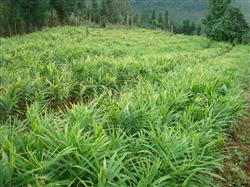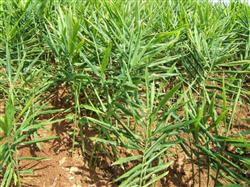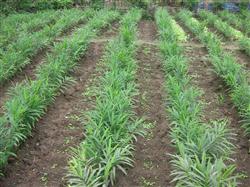What should ginger fertilizer pay attention to?

What should ginger fertilizer pay attention to? Please re-apply base fertilizer and increase phosphorus and potassium fertilizer to avoid more nitrogen fertilizer when planting ginger. Apply sufficient base fertilizer, mainly organic fertilizer, long-term and short-acting chemical fertilizer. Base fertilizer generally accounts for 40% of the total fertilizer application. Before sowing, 15 kg of imported compound fertilizer and 50 kg of calcium magnesium phosphate fertilizer can be used as deep base fertilizer per mu. After sowing, the effect of covering seed with high quality soil fertilizer, dried cow manure or mushroom soil is the best. Qualified farmers can cover rice straw after sowing to achieve the purpose of moisturizing, weed control and growth. On the basis of sufficient base fertilizer, a small amount of topdressing should be achieved for many times, and nitrogen, phosphorus and potassium should be used together. The seedling stage is mainly light and light fertilizer, and the amount of fertilizer can be increased appropriately in the middle and later stage of rapid expansion of ginger. There are two important fertilization periods in ginger's life, one is from Sun Mei's period to the fourth stage, which is the peak of fertilizer absorption in ginger's life, the absorption of nitrogen, phosphorus and potassium is 52.5%, 12.5% and 30.5% respectively, about June. Second, from August to September, the climate turns cool and the temperature difference between day and night is large, which is the prime time for rapid expansion of ginger. It is necessary to make use of rainy days to increase the amount of fertilizer applied. It is better to apply imported compound fertilizer and urea in the second time. If the rhizome of ginger is too dry and watered, the rhizome absorbs less nitrogen, phosphorus and potassium in the seedling stage, and the phosphorus absorption increases slowly in the vigorous growth period. The demand for nitrogen and potassium increases sharply, especially in the early stage of vigorous growth period, followed by nitrogen fertilizer. In the middle and later stages of the vigorous growth period, nitrogen is more than potassium, potassium is more than phosphorus. Therefore, in production, formula fertilization is carried out according to the law of ginger fertilizer demand, and timely topdressing nitrogen fertilizer is helpful to increase production. The fertilization of ginger can be divided into base fertilizer and topdressing. Base fertilizer is divided into organic fertilizer, cake fertilizer and chemical fertilizer. Organic fertilizer is applied in combination with soil preparation before sowing, generally applying 5 square meters of high-quality rotten chicken manure per mu, and rotary tillage after application; concentrated application of cake fertilizer and chemical fertilizer into the sowing ditch before sowing, generally 75 kilograms of cake fertilizer, 50 kilograms of nitrogen, phosphorus and potassium compound fertilizer per mu or 25 kilograms of urea, calcium superphosphate and potassium sulfate each. In addition to applying sufficient base fertilizer, three times of topdressing are generally carried out. The first time to pursue "strong seedling fertilizer": the plant growth in the seedling stage is small and does not need much fertilizer, but the seedling growth period is long. In order to promote the seedling growth, the first topdressing is usually carried out when the seedling height is about 30 cm and has 1-2 branches. This time, topdressing is mainly nitrogen fertilizer, and 20 kg of ammonium sulfate or diammonium phosphate can be applied per mu. If the sowing date is too early and the seedling stage is longer, it can be fertilized for 2 or 3 times with watering, and the amount of fertilization is the same as above. The second pursuit of "turning fertilizer": before and after the Beginning of Autumn, this is the turning point of ginger growth, but also the turning point of nutrient absorption, since then, plant growth accelerated, and a large number of nutrients accumulated to form product organs. Therefore, the demand for fertilizer and water increased, in order to ensure the high yield of ginger, the second topdressing was carried out by weeding the ginger field before and after the beginning of autumn. This topdressing plays an important role in promoting growth and rhizome expansion. This topdressing usually combines cake fertilizer or farm manure with long-lasting effect and quick-acting chemical fertilizer. With 70 kilograms of crushed cake fertilizer, 3 square meters of rotten chicken manure, 50 kilograms of compound fertilizer or 20 kilograms of urea, 30 kilograms of diammonium phosphate and 50 kilograms of potassium sulfate per mu, a fertilizer ditch was opened 15 centimeters away from the base of the plant on one side of the ginger plants. spread the fertilizer into the ditch and mix it with the soil, then cover the soil to seal the ditch, cultivate the soil, and finally pour water through. The third topdressing "Zhuang Ginger Fertilizer": in early September, when the ginger seedlings have 6-8 branches, it is also the period of rapid expansion of the rhizome, and the third topdressing can be carried out according to the plant growth, which is called "Zhuang Ginger Fertilizer". For ginger fields with weak or general growth and ginger fields with low soil fertility, quick-acting chemical fertilizers, especially potassium and nitrogen fertilizers, can be applied to ensure the nutrients needed for the rhizome. Generally, 2530 kg compound fertilizer or 2.5 kg ammonium sulfate and potassium sulfate are applied per mu. For ginger fields with high soil fertility and vigorous plant growth, little or no nitrogen fertilizer should be applied to prevent excessive growth of stems and leaves and affect nutrient accumulation. Zinc fertilizer and boron fertilizer can usually be used as base fertilizer or extra-root topdressing. When zinc-deficient and boron-deficient ginger fields are used as base fertilizer, 1kg of zinc sulfate and 0.51kg of borax are generally applied per mu, which are evenly mixed with fine soil or organic fertilizer, and mixed evenly with the soil in the sowing ditch when sowing: if used as topdressing and foliar spraying, 0.05% 0.1% borax per mu can be sprayed three times in seedling stage, seedling stage and rhizome expansion stage. Click to get more ginger planting techniques click to get more vegetable planting techniques
- Prev

How about weeding in ginger field?
How to weed the ginger field? Please guide the growth of ginger there are a large number of weeds and ginger seedlings for fertilizer, water, sunshine, so that ginger seedlings can not get normal nutrition and poor growth, resulting in reduced production. Therefore, in the seedling stage, timely weeding is an important management measure, but manual weeding is labor-intensive and labor-intensive.
- Next

How to water ginger seedlings?
How to water ginger seedlings? Please guide ginger to have different requirements for watering in different growing periods. The bottom water must be thoroughly watered when sowing, and the first water is not started until the emergence of seedlings reaches about 70%. After watering this water, it is often necessary to keep the soil moist to prevent the soil surface from hardening and affecting seedling emergence. Seedlings.
Related
- Where is it suitable to grow horseradish in China? it is expected to see the middle altitude horseradish in Alishan.
- How to prevent tomato virus disease reasonably? (Control methods included)
- Many people like to plant towel gourd on the balcony. What are the main points of this method and management?
- What crops can chili peppers be mixed with?
- Fertilization techniques and matters needing attention in Tomato
- What are the grafting techniques for peach seedlings in spring?
- Harm and control methods of root swelling disease of Chinese cabbage
- What are the pests of sweet potatoes? How to prevent and cure it?
- Symptoms, causes and Control methods of navel Rot in Tomato
- The cause of "Cucumber rotten bibcock" in Farmers' planting Cucumber and its Control Plan

